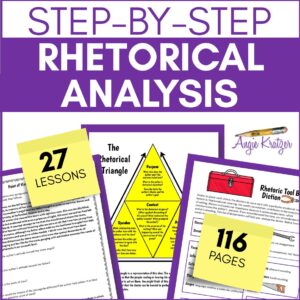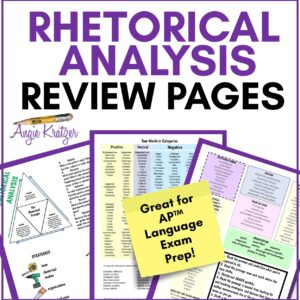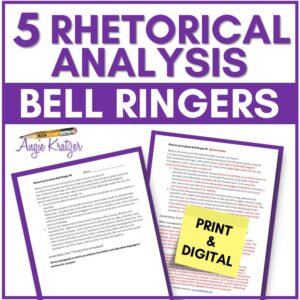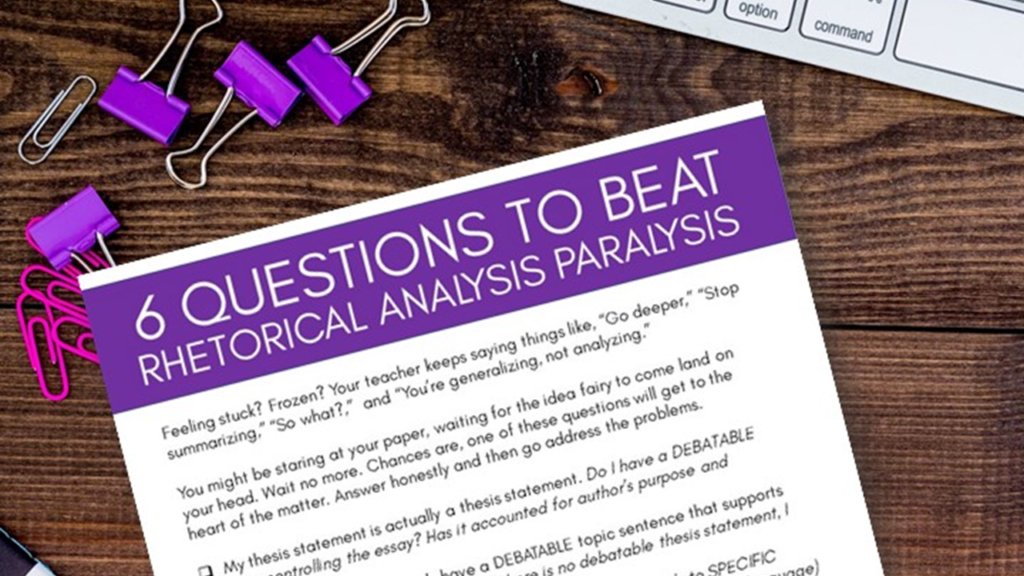
Ask twenty AP English Language teachers how to teach rhetorical analysis and expect to get twenty wildly different answers. A handful will tell a newbie to start with Cicero’s Five Canons of Rhetoric (Invention, Arrangement, Style, Memory, and Delivery) and drill down into each element. Another few will make the case that teaching students to form cohesive arguments should be the foundation of any rhetoric course, that all building of content and skills must start there. A few instructors will set up camp and roast to death the three persuasive appeals (logos, ethos, and pathos) until students can’t write beyond them. My metaphors of drilling, building, and weenie roasting are getting away from me here.
One amazing approach that I’ve grown to appreciate is thematic, holistic, and woven together in a way that makes my brain hurt. Here’s how it might work: A teacher chooses a theme and pulls in print and non-print material that fits that theme. For example, if the theme were war, she might use The Things They Carried, Patrick Henry’s “Speech to the Virginia Convention,” a pre-20th century letter from a British soldier, a piece of satire, a video clip of a 1969 anti-war demonstration, and a political cartoon. Within her instruction, she introduces a couple of strategies, a couple of devices, a couple of modes, and both analysis of and construction of an argument. By the end of the course, she has provided direct instruction for all content, skills, and processes and revisited what needed to be re-taught or reinforced. The benefit? Students make connections; they see that the ability to write in a mode and the ability to analyze a piece written in that same mode are symbiotic. The down side? Planning is a challenge, and the instructor has to see the forest and the trees. And the metaphors.
I want to be the kind of teacher who thinks holistically, but that’s a challenge for me. Although I’m a holistic grader, I’m an isolationist in my instruction. I’m a compartmentalizer. In fact, that trait shows up in every area of my life. Divided plates, for example. If my green bean juice travels to my mashed potatoes, it’s over. I recently found this tray on tigerchef.com, and I might just replace all my dishes.

Because of my need to separate and sort, I teach my AP Lang class in BIG chunks–rhetorical analysis, rhetorical modes, argumentation with a research emphasis, and then synthesis. That kind of content isolation works for me and affords me the opportunity to teach to mastery. We always reach back within each unit to pull skills from previous work, making connections as we go. This process has one distinct benefit: Students make the connections instead of the teacher. The tricky part is that everyone can get lost in the trees.
I put my rhetorical analysis unit down on paper (and Google Slides!), specifically as a way to help new AP teachers wrap their minds around strategies and devices. I save 99% of my instruction on argumentation for my second unit, Argumentative & Persuasive Writing: A Complete Unit.

My base RA unit includes 27 lesson plans. I’ve taught this unit on a 50-minute, year-round schedule and a 90-minute, year-round A/B day schedule, and both groups of students needed almost a semester to be proficient at this skill set. Here’s how I order my rhetorical analysis unit available on TeachersPayTeachers:
Introduction
Directions for Google Drive
Common Core Alignment Matrix
Lesson 1: The Rhetorical Triangle
Student Handout A: The Rhetorical Triangle
Lesson 2: SOAPS
Student Handout B: SOAPS
Lesson 3: Introduction to Style and Tone
Student Handout C: SOAPS Activator
Student Handout D: Rhetorical Analysis Overview
Student Handout E: Rhetorical Modes
Student Handout F: Alphabetized Tone Words
Student Handout G: Tone Word Connotation Sort
Lesson 4: Tone
Student Handout H: Tone Words in Categories
Lesson 5: Detail and Tone
Lesson 6: Paragraph Construction
Lesson 7: Introduction to Diction
Student Handout I: Diction Rhetoric Tool Box
Lesson 8: Diction Analysis
Student Handout J: Diction Scavenger Hunt
Student Handout K: Cartoon Analysis
Lesson 9: Thesis Statement Construction
Student Handout L: Thesis Statement Template
Student Handout M: The Power of Diction: Ethnic Slurs
Lesson 10: Writing About Diction
Student Handout N: Rhetorical Analysis Plan A: Device by Device
Student Handout O: Body Paragraph Template
Lesson 11: Introduction to Scoring
Lesson 12: Figurative Language
Student Handout P: Terminology Knowledge Spectrum
Student Handout Q: Figurative Language Rhetoric Tool Box
Lesson 13: Figurative Language Analysis
Student Handout R and Student Handout S: John Smith’s 1616 Letter to Queen Anne of Great Britain
Lesson 14: Imagery Analysis
Advanced Figurative Language Quiz (two versions)
Student Handout T: Excerpt from “Sinners in the Hands of an Angry God”
Lesson 15: Syntax Overview
Student Handout U: Syntax Overview Notes
Student Handout V: Basic Syntax
Lesson 16: Writing About Syntax
Lesson 17: Advanced Syntax Techniques
Student Handout W: Discovery Organizer: Advanced Syntax Techniques
Lesson 18: Syntax Analysis Practice
Lesson 19: Syntax Review
Student Handout X: Syntax Scavenger Hunt
Student Handout Y: Syntax Rhetoric Tool Box
Lesson 20 : Syntax Assessment (Test with key)
Lesson 21 : Point of View
Student Handout Z: Point of View Rhetoric Tool Box
Student Handout AA: Point of View Analysis Exercise (Slave Narrative)
Lesson 22: Organization
Student Handout BB: Point of View Analysis Exercise (The Stone Angel)
Student Handout CC: Organization Rhetoric Tool Box
Lesson 23 : Planning Options
Student Handout DD: Rhetorical Analysis Plan B: Author’s Organization
Lesson 24: Irony Lesson 25: The Introduction and Conclusion Lesson 26: Practice
Lesson 27: Scoring
Want a little help on rhetorical analysis? Grab this to help students get unstuck when they’re drafting commentary.
Before the exam, I give students this Rhetorical Analysis Review packet. It’s short, visual, and provided in both PDF and Google Slides. It’s perfect for remote learning. Since the 2020 exam will be Question 2 only, daily remote practice can be made simple with these five Rhetorical Analysis Bell Ringers.




